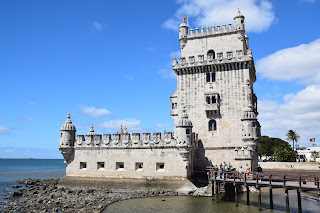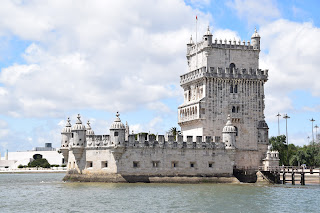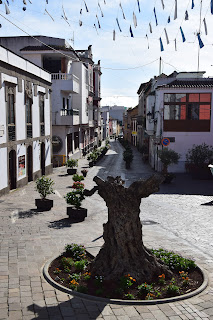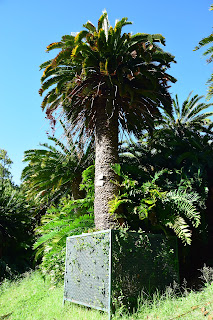We
had fancied a drive/sail tour for Lisbon and one Miguel Angelo was up for
addressing this challenge. We were met by him and driver Tiago. There was a
quick apology as we had coincidentaly arrived on the 50th
anniversary of the April 25th revolution and traffic was a problem.
Although this meant a couple of planned stops were removed from the itinerary
we were lucky that our first view of the castle included a fly past of F16s.
A few minutes later we were treated to them going past the
Sanctuary of Christ the King (inspired by the one in Brazil).
Our
next stop was Basilica do Sagrado Coracao de Jesus which was the last earthly
home of the Portugese Queen Mary 1. This seemed an appropriate stop given the
name of our cruise ship. Although the tram wires were hard to avoid the church
does have a beautiful park opposite.
Inside
is both grand and austere. The quailty of the marble detailing was particularly
impressive.
There are some beautiful parks with the Edward VII being
particularly impressive. The tree lined avenue seemed to go on forever.
As did the adjoining gardens with
sculptures at the top. I am not sure the colourful teddies added much value,
but they do detract from the fact that the water was missing from the main
stone sculpture. Adjoining is Portugal's largest country flag but, as it is smaller
than the one on top of the Australian parliament, it does not feature!
What was huge was the Jeronimos
monastery which was started in 1501. It is being refurbished and is
magnificent. Being a public holiday, the crowds stretched the 300 metre length
of the façade. Another visit with more time is needed!
We then moved onto the waterfront
and the allotted brief half hour was once more to give a flavour of what was available
as a tempter for a future visit. The first ‘eye catcher’ was a monument to the
age of discoveries in the heydays of the Portuguese Empire. Together with a
purely monumental ‘lighthouse’ both were built with lightweight materials for
the 1940 world exposition, torn down and then rebuilt in concrete in the 1960s.
By comparison the UNESCO Belem tower has been around since
1520. Originally a fortress it subsequently served as a lighthouse and then a customs
office.
With that the car part of the
tour was over and it was onto a 12 metre Beneteau yacht for some lunch and then
off to the high seas! Miguel was assisted by Susana who kept providing food
from a voluminous galley.
And what a spread! Cold meats,
cheeses and local bread to start with which were wonderful and washed down by
beer/wine or a soft drink. This was followed by three different seafood-based salads
(octopus, tuna and anchovies with garlic).
Then of course one could not
finish such a meal without Portuguese tarts. These were the best I’ve ever experienced
with moist custard and wonderfully crisp pastry all washed down with a local
fortified wine.
A quick clear away followed by some deft manoeuvres and we were off down the Tagus river. Most of the buildings,
sculptures and monuments seemed to have been designed for viewing from the
river – and of course the views were not blocked by crowds.
The first to catch my eye was
this one. No prizes for guessing what it is about!
The MAAT museum (Museum of Art,
Architecture and Technology) is a wonderfully slim building which contrasts
well with the original red brick power station. The diamond ring in the foreground
is made from car wheels.
The water side view of the Belem
tower is impressive. It is easy to imagine it originally surrounded by water although
these days (due to river changes) it is a tidal experience. The queues of over
an hour in length suggest this is also worth a future visit.
We then headed up river and got
as far aw QM2s berth before returning to port where Tiago was waiting to give
us a lift back to our ship.
We had a false start to our departure
and had to return to our berth due to a medical emergency. The upside was a
dusk departure which meant a couple of colourful shots. The first is the Praça
do Comércio.
And as we passed the Sanctuary of Christ the King the lights
were turned on.
And finally, just scraping under the April 25 bridge…
A wonderful day thanks in large part to Miguel and his team. It has shown we need to return to Lisbon and spend at least a week to give this wonderful city some justice to all it has on offer.

























































